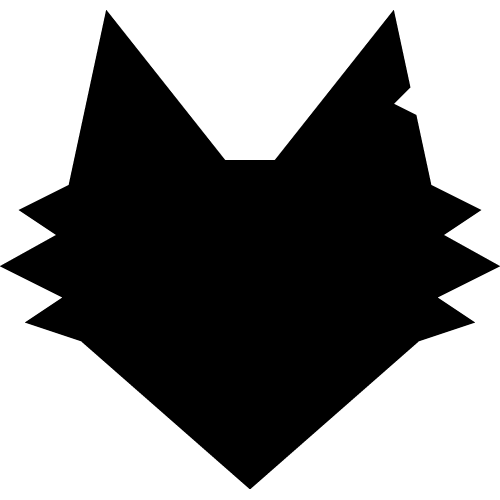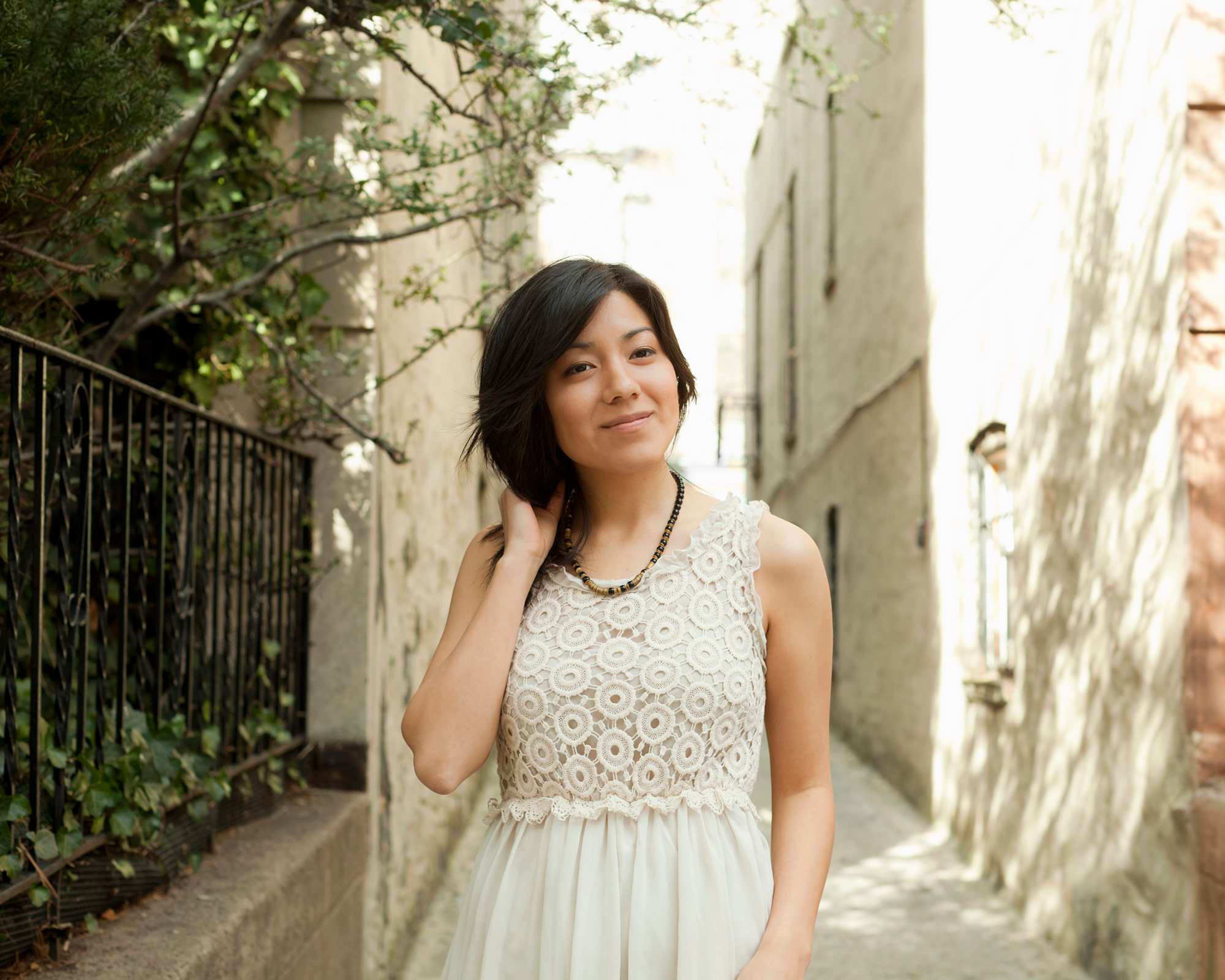
- Interview by Tina Essmaker March 20, 2012
- Photo by Kelsey Foster
Dana Tanamachi
- designer
- illustrator
- typographer
Dana Tanamachi is a Texas-bred, Brooklyn-based graphic designer and letterer who enjoys living a quiet life and working with her hands. She currently spends her days creating large-scale typographic installations in chalk and has been commissioned by clients such as Rugby Ralph Lauren, The Ace Hotel, West Elm, and Bloomingdale’s. Most recently, she had the honor of creating O Magazine’s first entirely hand-lettered cover for its February 2012 issue.
Interview
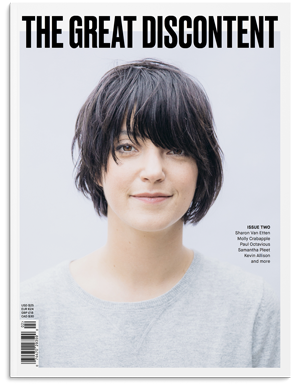 Editor’s note: An updated version of this interview, including new images and work, is featured in print in The Great Discontent, Issue Two, available in our online shop.
Editor’s note: An updated version of this interview, including new images and work, is featured in print in The Great Discontent, Issue Two, available in our online shop.
You’re currently working as a full-time chalk letterer and before that, you worked as a designer. Would you describe your path to what you’re doing now?
Sure. After graduating from the University of North Texas with a Communication Design degree, I came to New York for a three month internship with Good Housekeeping magazine. I thought I might be interested in editorial design and figured this would be a good way to test the waters. Turns out, I was not as interested as I thought! That’s what internships are for, right?
I never meant to move to New York, but after the internship was over, I landed my first job at SpotCo, a creative agency specializing in Broadway/entertainment branding. In essence, SpotCo designs the majority of the Broadway show posters—it was the perfect first job for me. It was there that I was able to put my knowledge of graphic design history to the test. One week, I’d be creating type for a show set in the Victorian era and the next week, I’d be researching mod 1960’s type for the musical, Catch Me If You Can. SpotCo fed my addiction for hand-lettering. I knew the basics, but I simply wanted to get better. That led to practicing drawing letterforms after hours or on weekends.
After a year and a half at SpotCo, I took a design position at Louise Fili Ltd, a boutique studio specializing in the design of restaurants and food packaging. Louise is known for her beautiful, custom typography, so it was an honor and pleasure to make a new home in her studio. Under Louise, my job description looked a bit different than my role at SpotCo. For example, I was now dealing directly with clients on a daily basis, which was great practice and preparation for the next season in my career. I was also no longer drawing letters or manipulating type; it was my job to take care of existing clients’ needs instead of experimenting with new typographic treatments or logos. That task was left to my talented co-worker, John Passafiume, who is damn good at it!
At that time, it became even more important to create personal projects where I could continue to practice lettering. Being on the computer all day, I didn’t want to lose the ability to draw with my hands—I didn’t want to get rusty. That actually became a very real concern, which spurred me on to pursue creative typographic outlets in my spare time. That’s where the chalk came in. Did I ever think it would become something I could do full-time? Never. Am I glad it did? Of course.
There’s an obvious design element in your work. Are you doing strictly chalk lettering or are you doing any other type of work as well?
At this time, I’m pretty much strictly chalk when it comes to client work or commissions.
You must have one of the most fun jobs in the entire world.
It is fun and it’s really satisfying. At the end of the day, my back hurts and my hands are a little raw, but it feels good to have done something physical.
Since this wasn’t what you started out pursuing, was there an “aha” moment along the way when you started to play around with chalk lettering?
Absolutely. I guess I could start by giving a bit of background on the chalk. The first time I ever picked up a piece of chalk in this way was a few years ago. My friends were having a themed housewarming party—The Great Gatsby—in Brooklyn and I stopped by with a friend from college. There was a big chalk wall with several quotes scribbled all over it, which I was really drawn to. To the side, they had a smaller, blank chalk wall. My friend said, “You’re artsy, right? Why don’t you draw something? Here’s a piece of chalk.” I turned to the friend who I was with and said, “Let’s draw the word ‘Brooklyn’.” He started on the “B” and I started on the “n” and we were going to meet in the middle, but in a few minutes, I was already on to the “r” and he was still drawing the “B”. We were laughing.
I didn’t think anything of our drawing, but someone came up and asked, “Did you all just do that?” Others started coming over and asking us to take their picture in front of it. My friends all said, “I didn’t know you could do that!” Well, I didn’t know I could do that either. It ended up becoming the photo wall for that party and after that, everyone uploaded their pictures to Facebook. For the next several parties, I would come over beforehand to draw other themed backdrops. I did this for about a year in complete obscurity—it was just “our thing”—something that was birthed out of my community of friends here in Brooklyn and something that emerged out of celebration.
These chalk backdrops gave me a good excuse to use my hands and continue drawing letters. I only considered it as practice because I thought, it’s just chalk—it’s so temporary and there’s no consequence. It was really freeing because I wouldn’t even sketch beforehand; I would just go for it. I would leave feeling full of creative energy and loved seeing my friends laughing, dancing, and celebrating with my work as the backdrop. I also loved working at such a large scale, which was something new for me. I suppose the “aha” moment came when I realized I had found the thing that could allow me to practice and improve my lettering skills, serve my friends, and have some fun in the process.
There’s a huge satisfaction that comes from physically working with your hands and having created something when you’re done.
Exactly. There are some people who are just born to design on the computer and they’re amazing masters of the pen tool, but that’s just not me. If I’m honest, I consider it to be one of my limitations. It’s probably why I leaned so heavily towards hand-lettering—it was easier than clicking around in Illustrator all day. Sometimes your limitations can be a launching pad into an unexpected story.
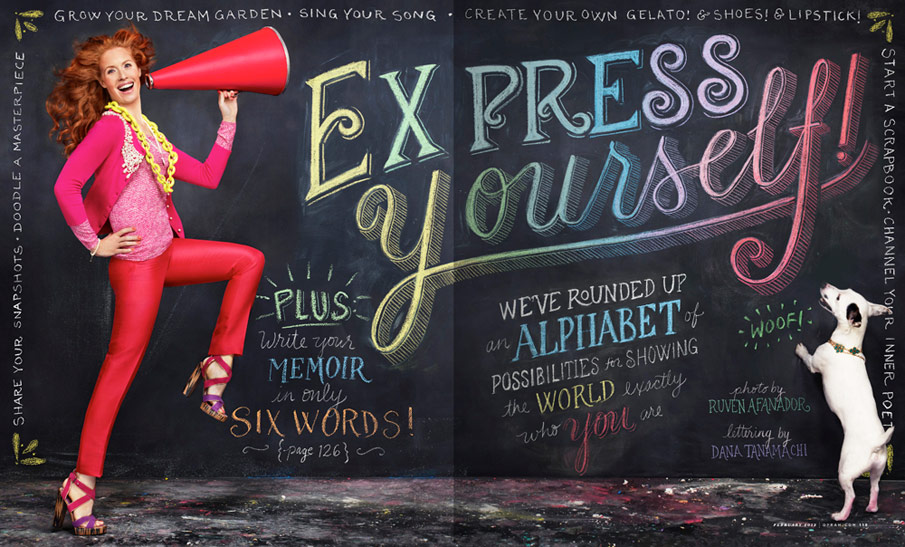
“At the end of the day, my back hurts and my hands are a little raw, but it feels good to have done something physical.”
Did you then start to get commission work through word of mouth?
Yeah. Like I said, I did installations for all those parties and everyone would go home and upload their photos to Facebook. I got my first commission from a friend of a friend who saw the photos online. She worked at Desiron, a modern furniture gallery in SoHo. They were launching a new collection and she asked me to come by and do a wall for them, which I did one day after work. My second commission was from another friend of a friend who also saw the photos on Facebook and worked at the Google offices in Chelsea Market. They were opening a new wing in their office, so I went over there on a Saturday and did a large installation to christen their new space. So yes, at first it was solely by word of mouth and social networking.
Did you continue to work your day job for a while and then make the transition?
Yes, absolutely. 2011 was certainly intense! It was challenging, but also exciting; I refer to it as my “hustle year”. I was enjoying my full-time job at Louise’s studio where we had all developed a great system of working together. I would be there during the day and then after work, I’d go straight home and bust out the chalk ’til the wee hours of the morning—then sometimes I’d wake up early to finish. During my lunch hour, I’d try to send an email or two. It was a really full year and sometimes I look back and don’t know how I survived.
And those weren’t the only things I had going on. I had people and friendships in my life that were—and still are—very important to me. I wanted to be faithful with those relationships and I needed them in order to stay connected and grounded. Even though most of my time was taken up with work, it was still vital for me to make time for people. Sometimes I succeeded; sometimes I failed, but grace abounded.
When commissions really started picking up in early 2011, it was certainly an exciting time. Like any normal person, I daydreamed about all the possibilities and what it would be like to turn my dream into my day job, but to be honest, keeping my full-time job for the next nine months while inquiries were steadily increasing was probably the best decision I made last year. After all, I loved working with Louise and John and I wasn’t quite ready to part ways.
During that season of serious hustle, I read a book called Quitter by Jon Acuff. In it, he encourages people not to bail on their full-time jobs as soon as they feel like their dream is gaining some traction. These were wise words that I needed to hear. A full-time job provides stability so that you can take more risks on your dream. In our culture, we’re prone to demonize our day jobs and exalt our dream jobs, but we fail to see that the former can be a platform for the latter. In his book, Acuff explains that the word “no” is the most valuable word you have as someone working towards your dream. He says:
“…when you still have your job you don’t have to obsess about the consequences of saying no [unpaid bills, going hungry, etc…]. You can instead focus on the benefits of saying yes to the right opportunities. When you keep your day job, all opportunities become surplus propositions rather than deficit remedies. You only have to take the ones that suit your dream best.”
Each time I was approached for a commission last year, I would run it through my mental filter and ask, “Since my time is so limited, does this align with what I want to do or what I’m about?” If the answer was no, I didn’t have a problem saying no to the job because I already had security—I had a full-time job. My day job allowed me to only take on the jobs I really connected with. When I read Quitter, it changed my perspective and encouraged me to stick with my full-time job and continue doing commissions on the side. I’m glad I did both for a while.
That’s really great insight. Did you go out on your own at the end of 2011?
September 30, 2011 was my last day at Louise Fili Ltd. A couple weeks prior, I had this moment where I questioned if I was doing the right thing. I had jobs lined up, but I was still wrestling with some hard questions. That day, as I was in the middle of a mini-crisis, I got a call from the folks at O Magazine who asked me to design the cover of their February issue. Yes, they wanted me to hand-letter the entire cover in chalk and they’d photograph Oprah standing in front of my work. I couldn’t stop laughing.
They asked me to come in that next Wednesday, but the earliest I could do it was Thursday, which happened to be my last day at Louise’s studio. So when Thursday rolled around, I literally said my goodbyes at Louise’s, hopped on a crosstown bus, and worked into the night on the O Magazine cover at a photo studio in the Meatpacking District. That opportunity felt like a huge—apparently laughable—confirmation that I was doing the right thing. I needed that extra push.
Tina: I just saw that cover when I was standing in line at the grocery store the other day and thought, “Dana did that!”
Was creativity a part of your childhood?
I didn’t take any formal art classes when I was younger, but I was a hardcore crafter. I was in Girl Scouts—so, you name it, I’ve made it. My mom was supportive in that she always had supplies around, so I was always making things with my hands—cutting and folding paper, scribbling with crayons, gluing silly jewelry pieces, going the extra mile on book report posters or science dioramas. I remember feeling a sense of comfort, joy, and pride when working with my hands. I was in my element.
On family road trips, I’d draw my dream house with my room and extra rooms for all of my dogs. I was pretty imaginative, but I never considered myself an artist and somehow, I still don’t. I very much feel like a designer.
Were your family and friends supportive of your decision to pursue design and were they supportive when you decided to do chalk lettering full-time?
My friends and family are so supportive and that has made all the difference. I’ve been very honest with friends and family about what I’m doing, where I’m going, and explaining the process to them. This whole thing was really birthed out of my community in Brooklyn, so they’ve seen it all along—it’s really unfolded before their eyes. My friends have been great about speaking support and encouragement into my life.
My parents have been encouraging as well. I don’t think they ever dreamed that their daughter would be doing random chalk art for a living, but they’re cool with it because they know that I love what I do and I’m putting my formal training, which they graciously paid for, to use.
That’s awesome. It’s good to have people around you to help you believe in yourself and your abilities.
That’s something I’ve learned from this season of life. When someone sees something in you and they have the courage to speak it out, it changes everything. I learned the other month that the root of “encourage” literally means to put courage into someone. That is what my community does. I’ve learned from them that if you see something special or unique in someone, don’t just think it—tell them. Our words hold a lot of power.
I recently starting lecturing at a few universities. I’m by no means the world’s best public speaker, but what I love is connecting with students afterwards and asking them about what they like, what they want to do, what’s life-giving for them and being able to encourage them in that.
We’re curious about how you describe what you do to others?
If I’m on an airplane and someone asks what I do, I usually just tell them I’m a graphic designer. It’s hard; I don’t want to say “chalk artist” because a certain image arises in their mind—it’s not a bad one, but it’s very different from what I do. I usually say I’m kind of like a muralist, but I only draw letters in chalk.
You mentioned that you have a really great community of peers. Have you had any mentors along the way?
Yes. I was thinking about this today. There are a couple of people who have been key players in this journey. One is a professor I had back in college named Meta Newhouse. She was a grad student at the time and later went on to become a professor of design at Montana State. Back then, I asked her if she would meet with me a few times a month because I really respected what she did; she was an art director at a respected firm in Dallas. So, she had me over for coffee and I would show her what I’d been working on. She was extremely positive, reassuring, and let me ask all the questions I could think of. I really appreciate and value the time I had with her. Last fall, I gave a lecture at Montana State; it was so great to see her flourishing and doing what she does best. Her students obviously loved her as much as I did!
Also, here in New York—I don’t know if you’re familiar with Jeff Rogers? He’s an incredibly talented designer and illustrator. Jeff—a fellow Texan—got me my first job at SpotCo; he gave me my first chance. He offered me a two week freelance stint that turned into a year and a half. It certainly had its challenges; it was a new job and I was also new to the city. Sometimes I would go to Jeff in tears needing someone to talk to and he was always there to offer incredible encouragement. I tell our mutual friends that I wouldn’t still be in New York if it wasn’t for Jeff. I might’ve given up on my dream long ago. He’s really looked out for me and is definitely the big brother I never had. We still see each other pretty often and sometimes he even comes to me for advice now. (laughing)
And Louise as well. She was very kind in taking me in and letting me work with her for a year and a half. Louise knew I had had a difficult experience before coming to her, so she was very patient in walking through things with me. She restored my faith in multiple areas—she knows what those are. I’m very thankful to her for that.
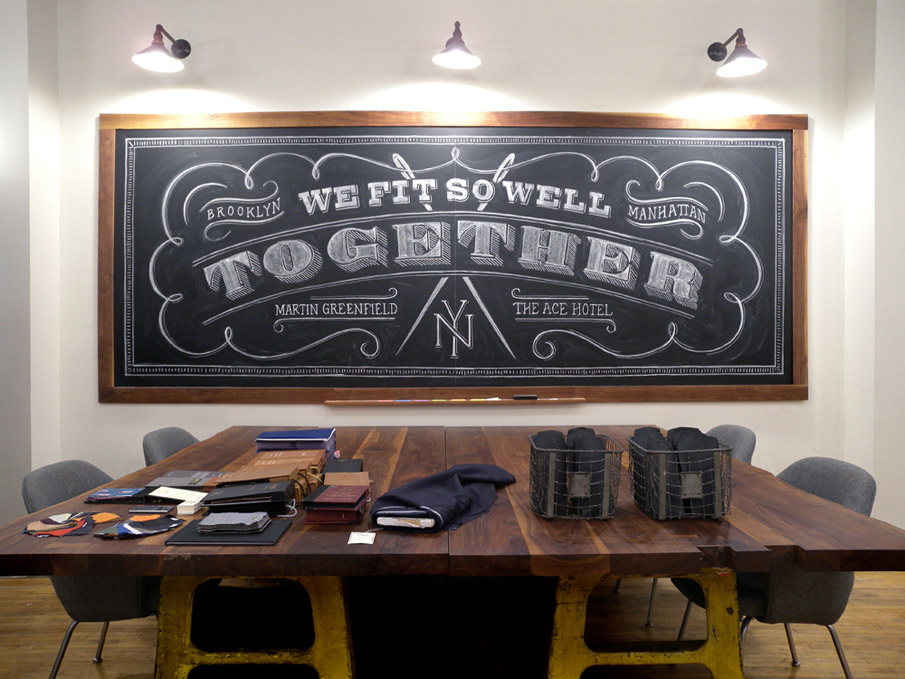
“When someone sees something in you and they have the courage to speak it out, it changes everything…if you see something special or unique in someone, don’t just think it—tell them. Our words hold a lot of power.”
Was there a point in your life when you decided you had to take a big risk to move forward?
I happened to move to NY the same year that a few of my friends from Texas did, but after a year here, they all left and went back home. I was all alone. I wanted to move back to Texas, but after really considering it, I knew I was supposed to stay here. It seemed bleak. New York can be a lonely place when you don’t know people and you’re still trying to find your niche. It was a huge temptation to run away, but I’m glad I stayed. It was well worth it.
I’m trying to think if there’s anything else. Well, at the end of last year, I was really burned out. There were a lot of things going through my head and it was a confusing time. Where should I live? What should I pursue? As I again took time to consider the issues and talk with trusted friends, I decided to stay in New York, but simply cut back on a lot. I took a month off over the new year, which might seem like a risk, but it wasn’t a risk to me—it was a necessity. I needed to stop working so that I could reflect on my work. I feel like I’ve struck a much better balance in 2012 with only having one job. (laughing) I now have a healthy rhythm to my life here. I’m content and thriving again, not just barely getting by.
Do you feel a responsibility to contribute to something bigger than yourself?
Yes. Absolutely. On my desk, there’s a sticky note that says, “Faithfulness over success.” At the end of my career, I want to ask myself if I’ve been faithful with what I’ve been given—that includes the people and relationships in my life. I’m very protective of my friends and family and I want to be present. That equals success to me. It’s not worth it if you tank all your relationships, become self-obsessed, and all you have to talk about is the work you produce.
One of the things that I also have posted on my desk is a sticky note that says “self-forgetfulness”. It’s all too easy to get caught up in what we’re doing or what’s being said about us. Let’s be honest—whether we tend to think too highly or too poorly of ourselves, either way we’re thinking about ourselves. The world doesn’t revolve around us; how can we look outside ourselves to speak encouragement, offer words of wisdom, or meet a practical need? I need help with this!
Is there anything you hope to contribute through your work?
I want what is most important in my life to be reflected in my work and it might be things that aren’t so obvious—it might not be the phrase I’m lettering. I truly value things like simplicity, celebration, and quietness. I would love to draw someone into that stillness while observing one of my large-scale pieces. That would be wonderful and I hope for that. I do appreciate when people tell me that a piece of mine made them stop, look, and see the layers in a particular area or notice details that they initially overlooked.
Just the nature of chalk—it’s a humble medium. You can get chalk anywhere; almost everybody has memories of it. There’s an element of nostalgia about it that takes people to a simpler time and place. I would love to recreate that for somebody and invite them to just be still, observe, perhaps remember—especially in a place like New York City where busyness and distraction reign supreme. Personally, creating these pieces takes me out of that hustle and bustle. I still only use the same tools as when I first started: a wet rag and a piece of chalk. I try to keep it bare bones so that it doesn’t distract people.
Are you satisfied creatively?
I think so. Yes. Chalk used to be my outlet, my “play”. Now that it has become my full-time job, I’ve purposely added other elements of “play” to my life this year. My New Year’s resolutions were to join a choir and read a book in its entirety. I’m happy to report that I’ve done both and am loving it; both have helped me feel creatively satisfied in addition to the chalk.
Do you have any thoughts about where you’d like to be in 5 or 10 years?
I had this conversation with Jon Contino recently. If it all ended tomorrow, I’d still be content. I’m so humbled by the opportunities that I’ve already been given in my young career. I don’t take it for granted and I’m very thankful. Maybe down the road I’ll go back and rejoin the workforce. I don’t know. I guess I hold my career very loosely in my hands. And, in ten years, I hope to have a family.
If you could give advice to another designer starting out, what would you say?
You have to do things on the side—things that are life-giving for you. Ask yourself what you would do if nobody paid you. What makes you feel fulfilled and excited? Whatever that is, do it. It might not even be design related.
Remember that your first job isn’t necessarily going to be your dream job. In this age of immediate gratification, some things still just take time. So use that time wisely! Practice. Ask yourself how you can take practical steps towards your dream. That might mean carving time out of your schedule, being a bit more disciplined, researching. Continue learning and when you get really good at something and you love it, oftentimes people will notice. But I would say, don’t do it for people to notice; be perfectly content staying in obscurity. In Quitter, Jon Acuff reminds that:
“Anonymity allows you to make big, gross mistakes without everyone watching. Anonymity is the best creative lab because you’ve got nothing to lose. Anything is possible. Anything is on the table. There are no expectations to miss, no fans to disappoint, no follow-up fears.”
And if there comes a time when you start getting noticed for your dream, keep your full-time job and be patient while you keep pressing in toward your dream.
You’re in New York and are originally from Texas. That’s a big change. How does living in NY impact your creativity?
Well, there’s endless inspiration everywhere you turn, especially in Brooklyn. I love the people and the architecture; there’s so much history. You can go to the library, a Broadway show, the opera, or a Jay-Z concert. Whatever you want—it’s out there. The stereotypical thing to say is that there’s so much energy here, but it’s true. There’s an energy and a current.
A huge part of it is about the community you’re in. I happen to have a really tight-knit and creative community full of folks who are grounded. I don’t know if that’s rare, but I’m thankful for it.
There are also endless opportunities here. I don’t think I could be doing what I’m doing anywhere else. Even the style I work in—it feels very Brooklyn. I’m in the right place.
You’ve touched on this a lot, so I know it is important to you to be part of a creative community of people. Do you want to add anything about what that does for you?
Sure. Every Tuesday, friends come over and we cook a meal together and catch up on each other’s lives. Being known and knowing others is so important. To have people who know your story, know what you’re about, know your strengths and weaknesses, and can speak into your life is good. Like I mentioned, there is a current in NY and it’s easy to get swept away—having those people really grounds you. They can remind you of how you’ve changed and grown when you do get discouraged.
What does a typical day look like for you?
I usually wake at 8am and get ready for the day. I have some coffee, sit on my couch, and read until 10am. I take time to be still and think about the events of the day and how I’m going to approach them.
Around 10am, I sit down in the studio and sift through emails. Lately I’ve been prepping for a lot of jobs, so I’ll sketch for a few hours and have fun looking through resources and books. I’m working with chalk maybe one or two days a week. On the other days, I’m sketching, meeting with people, or on conference calls.
Do you have a studio at home?
I do have a studio at home. I have a two bedroom apartment here in Brooklyn and the second room is a dedicated studio space that I share with a friend who is a fashion designer and jewelry maker.
What I love about my job is that I can work here in the studio on the chalk wall or a lot of times I get commissioned to go work on site. It changes up my schedule, which is a positive thing because I’m working solo most of the time. I enjoy getting out, meeting people, and working in new environments.
When you do an installation somewhere, is it made permanent?
No. I don’t use any kind of fixative.
So it could just get totally erased?
Yup. That’s something I value—the simplicity. Chalk is ephemeral and I want to keep it that way. I think people value it more when they know it could be wiped away in an instant.
That’s so true. Now for the easy questions. Current album on repeat?
What am I listening to? I’ve had Alison Krauss & Union Station on repeat for the last couple of weeks as well as Dylan Sneed’s Texodus.
Any favorite TV shows or movies?
I’m a huge, huge fan of How I Met Your Mother. It’s sad, but I feel like I’m connecting with old friends when I watch it. It makes me laugh out loud. I can’t say that I really watch movies though.
Do you have any favorite books?
Yes. My favorite book is called Celebration of Discipline by Richard Foster. It’s about the classic disciplines of Christian spirituality. Honestly, a lot of the things I mentioned earlier that I value—simplicity, solitude, contemplation, and celebration—I learned to define from reading this book. I find myself revisiting it on a regular basis.
What other books? Richard Foster and Charles Spurgeon are my favorites. I love to learn new things and put them into practice.
What’s your favorite food?
Tex-Mex for sure! I mourn it every day here in NY. I’ve already planned four trips to Texas this year—I’ll say it’s for work, but really it’s for the Tex-Mex. (laughing)
What kind of legacy do you hope to leave?
Like I said before: “Faithfulness over success.”
How do I say this? I feel like there are so many things I think about all the time. I want to be the best steward possible of what I’ve been given and not waste time. I want the people who are in my life and who I encounter to feel like they’ve really been taken care of, loved well, and considered. I want to leave a legacy of thanksgiving—of thankfulness.
And there’s a difference between loving people in general and loving people when it gets hard; or loving people who aren’t like you. Sometimes the most loving thing is talking about the hard stuff or challenging each other. It’s not just the fluffy feelings; it’s like, let’s do this together in a real way where we’re tangibly seeking the best for each other. I may have been given a gift or talent, but in the end, I want to sincerely, genuinely love people well. 
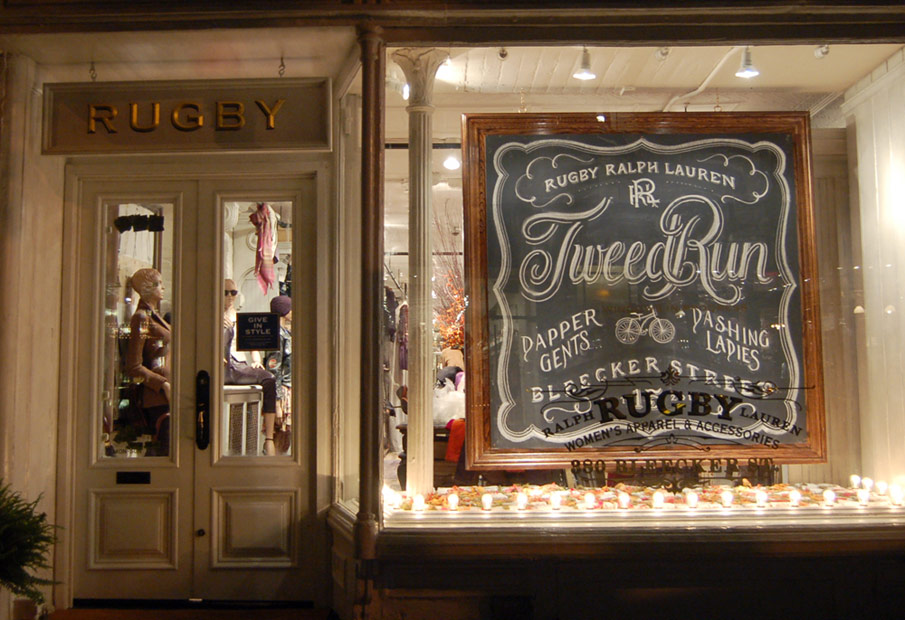
“Ask yourself what you would do if nobody paid you. What makes you feel fulfilled and excited? Whatever that is, do it.”
